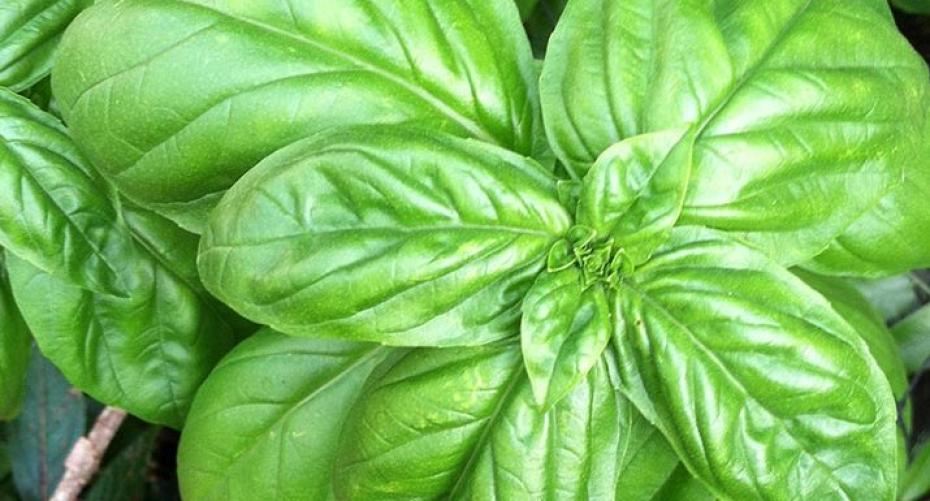Basil is one of the main herbs for Mediterranean and Asian cooking
Basil is one of the herbs you cannot do without, an essential part of Mediterranean, Indian, Vietnamese and Thai cooking. It has a reputation for being difficult to grow, but once you follow a few golden rules then it’s easy. Basil belongs to the mint family and there are over 40 different varieties; so there is definitely one to suit your style of cooking. It is generally thought of as a Mediterranean herb but it originated in Asia; Thailand, Vietnam and India. In the tropics it is grown as a perennial but in the UK it is an annual. It has antiviral, antimicrobial and antioxidant properties, and is also a rich source of vitamins, particularly vitamin A, and minerals, especially iron. Current research is looking at its potential as a cancer treatment. Ancient cultures placed basil with the dead to ensure they had a safe journey to god.
Sowing seeds
Outside
Choose a well drained site in full sun and sow when all danger of frosts has passed. They are quite sensitive to the cold and wet so need a hot dry site. They need a free draining soil so you may need to incorporate some horticultural grit in order to aid drainage. Sow thinly in a row about quarter inch deep. Keep damp not wet. Thin out the seedlings when they have 3 pairs of leaves, to 20 – 30cm (8 – 12”) apart. Either pot on the seedlings you have thinned out or use as micro greens.
Inside
Sow about 2 months earlier than you would outside, using a free draining seed sowing compost. Remember to keep damp. When ready to prick out either transplant them outdoors or grow in pots on a warm, sunny, south facing windowsill. A 15cm (6”) pot is the minimum size you need; it may need potting into a larger pot once it has put on a lot of growth.
Growing
Outside
Make sure they are watered regularly. Pinch out the top and subsequent side shoots. This will make a sturdy bushy plant with lots of leaves. If you don’t pinch out, the plant will be tall and straggly and not have many leaves, and will also be susceptible to damage in wet, windy weather. If it starts to flower remove them, unless you want to collect seed for next year. Once it has produced seed it will stop producing leaves, and no longer be any good so unless you are collecting seed it will need discarding. Don’t over water or over feed as this will produce rapid growth which is susceptible to pests and diseases, and will produce leaves with a less intense flavour.
Inside
Water from the bottom in the morning; put water in the saucer and discard any remaining after half an hour. Pinch as for outside growing. Feed once a fortnight with a weak solution of a balanced fertiliser.
Pests and diseases
Keeping the plant strong and healthy is the best way to combat pests and diseases, as pests such as aphids are attracted to soft sappy new growth. The main fungal attacks come from: Fusarium wilt, a soil borne fungus which kills young plants; Pythium, damping off and Botrytis. All these can be prevented by not letting the compost become too cold and wet and keeping a good flow of air around the plants.
Harvesting
Take leaves as often as possible as this will stimulate the plant to produce more.
Storing
Keep picked leaves damp in a plastic bag in the fridge for 2 – 3 days.
Oven dry by placing on a baking sheet in a warm oven for 3 – 4 hours. Store somewhere dark as the light increases the rate of flavour loss.
Combine in a pestle and mortar with pine nuts, garlic, parmesan and olive oil, and store as pesto.
Combine into butter then freeze.
Recommended varieties:
Sweet Basil for Mediterranean cooking.
Thai Basil for Asian cuisine, particularly Thai and Vietnamese.
Holy Basil for Thai cuisine and as a herbal tea.
Dark Opal Basil for a sweet, slight liquorice flavour good as a micro green on salads.

Tomato and Mozzerella Salad
Slice beefsteak tomatoes, top with a slice of mozzarella.
Finely chop spring onions, tear basil leaves and sprinkle both over the tomatoes and mozzarella.
Season with seasalt and ground black pepper.
Sprinkle over equal quantities of white wine vinegar and olive oil. Leave to absorb for 30 minutes. Serve with crusty bread.
Ken Hom’s Stir-fry Chicken
2 tbsp vegetable oil
450g boneless skinless chicken thigh, cut into chunks
3 tbsp roughly chopped garlic
3 tbsp finely slice shallots
3 fresh chillies, de-seeded and finely chopped
2 tbsp fish sauce (nam pla)
2 tsp dark soy sauce
2 tsp sugar
Large handful Thai Basil leaves
1. Heat a wok until hot, add 1 tbsp of the oil. When very hot add the chicken and stir-fry over a high heat for 8 – 10 minutes, until browned. Take from pan and set aside.
2. Reheat the wok and add the remaining oil. Toss in garlic and shallots, stir-fry for 3 minutes until golden.
3. Return the chicken to the wok and add chillies, fish sauce, dark soy sauce and sugar. Stir-fry over a high heat for further 8 – 10 minutes until chicken is cooked through. Stir in Basil leaves and serve.




![Kingsbury-bench-05[1].jpg](http://www.hayesgardenworld.co.uk/cdn/shop/files/Kingsbury-bench-05_5B1_5D.jpg?v=1712162737&width=1500)
![Kingsbury-bench-01[1].jpg](http://www.hayesgardenworld.co.uk/cdn/shop/files/Kingsbury-bench-01_5B1_5D.jpg?v=1712161065&width=1500)
![tw17a-4947_0[1].jpg](http://www.hayesgardenworld.co.uk/cdn/shop/files/tw17a-4947_0_5B1_5D.jpg?v=1712161495&width=1500)
![tw17a-4947_tenbury_5ft[1].jpg](http://www.hayesgardenworld.co.uk/cdn/shop/files/tw17a-4947_tenbury_5ft_5B1_5D.jpg?v=1712161172&width=1500)
![tw17a-4952_tenbury_4ft[1].jpg](http://www.hayesgardenworld.co.uk/cdn/shop/files/tw17a-4952_tenbury_4ft_5B1_5D.jpg?v=1712161034&width=1500)
![thumbnail_IMG_1565-kik_2[1].jpg](http://www.hayesgardenworld.co.uk/cdn/shop/files/thumbnail_IMG_1565-kik_2_5B1_5D.jpg?v=1712226536&width=1500)
![thumbnail_IMG_1565-kik_1[3].jpg](http://www.hayesgardenworld.co.uk/cdn/shop/files/thumbnail_IMG_1565-kik_1_5B3_5D.jpg?v=1712159637&width=1500)



![WD-XgESA[1].jpeg](http://www.hayesgardenworld.co.uk/cdn/shop/files/WD-XgESA_5B1_5D.jpg?v=1712159609&width=1500)